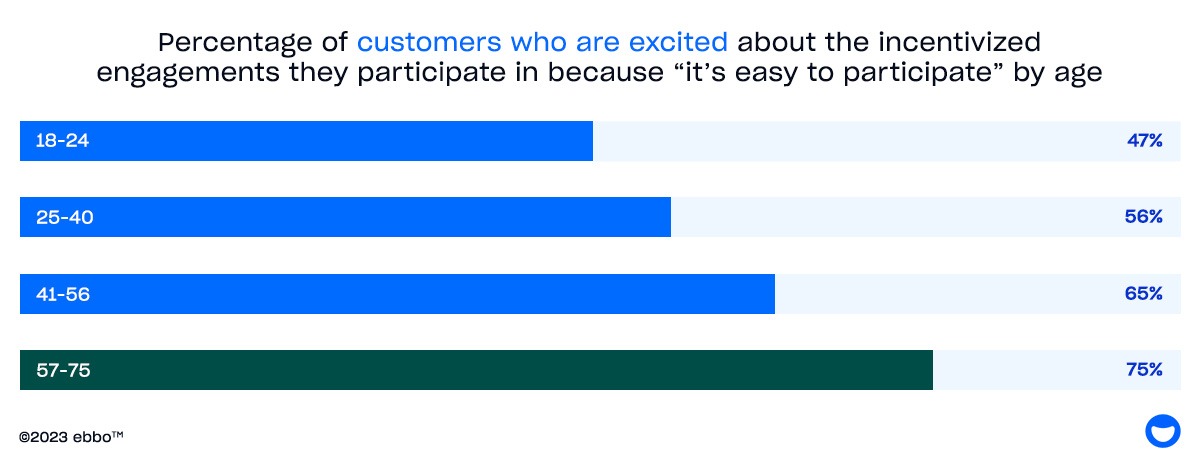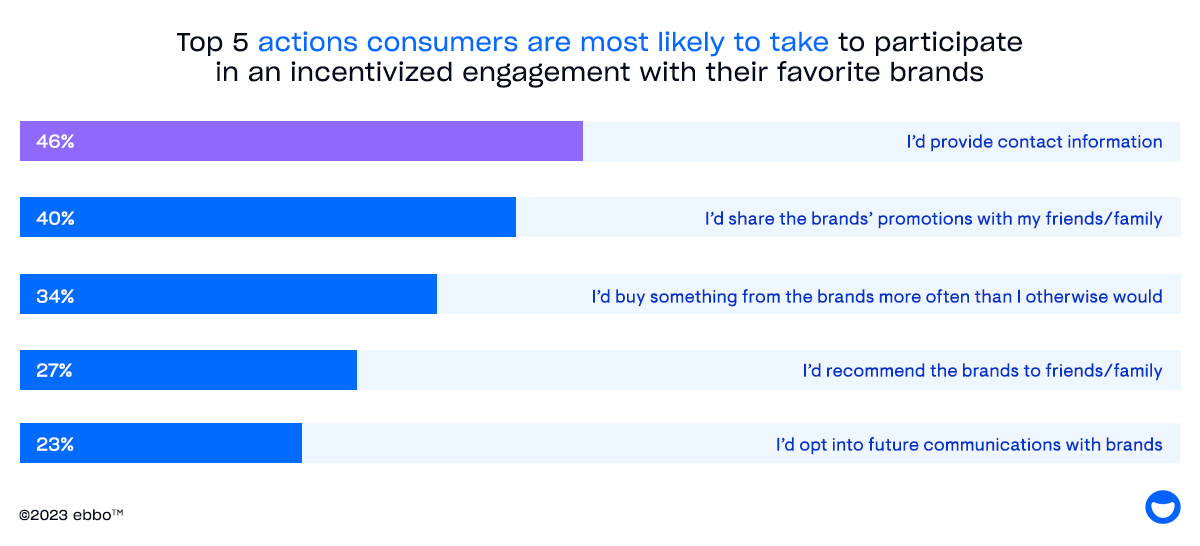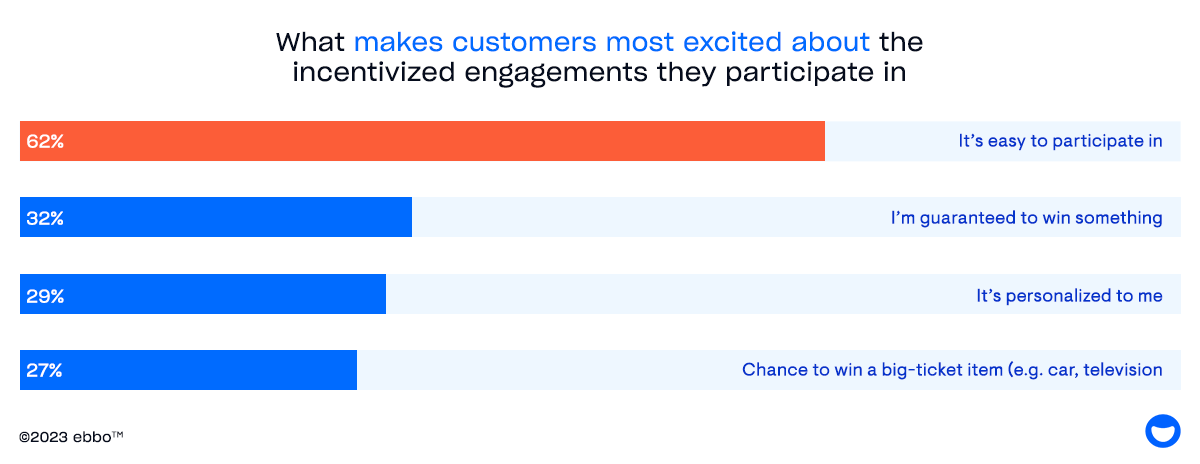Given today’s technology and abundance of choices for consumers, repeat customer engagement is more difficult to achieve than ever. That’s why more brands are getting creative with their loyalty strategies — turning to new tactics like loyalty amplifiers, which offer incentives for consumers to engage.
But how do consumers feel about these incentivized engagements?
The 2023 Customer Engagement Data Study: How Incentives Motivate Consumer Behaviors surveyed 2,500 U.S. consumers and reveals critical insights about what motivates consumers to engage with incentives and provide your brand with more opportunities to strengthen customer relationships.
Here are 12 new customer engagement stats that will show how offering incentives can positively impact your customer engagement efforts.
1. Ninety percent of consumers agree they’re more likely to engage with a brand if it offers incentivized engagements
Even with loyal customers, you’re always on the verge of losing them to a competitor. Given the abundance of consumer choices, make sure you’re offering consumers what they want.
This first stat captures the power behind incentivized engagements. It clearly shows that most consumers would engage with your brand if you offer incentivized engagements.
There are various ways your brand can leverage incentives through your loyalty program to engage and retain your members. Those include sweepstakes, user-generated content (UGC), trivia, instant wins and social media incentives.
Incentives drive brand affinity by offering unique and exciting ways for consumers to engage with your loyalty program.

According to the data study, all demographics are attracted to incentivized engagements. Here is a breakdown of the percentage of customers who are excited about the incentivized engagements they participate in because “it’s easy to participate in.”
- 18-24 (47%)
- 25-40 (56%)
- 41-56 (65%)
- 57-75 (75%)
Make sure your incentivized engagements capture customers’ attention and provide memorable experiences.
2. Nearly 60% of consumers have switched from a brand they regularly purchase from to a better brand that offered incentivized engagements
This stat showcases the allure of incentivized engagements. If nearly 60% of consumers switch from a brand they were loyal to and opt for a brand that offers incentivized engagements, that sends a clear message to all brands.
And, if you offer incentivized engagements, make sure they are structured to capture customers’ attention and provide memorable experiences because, if they don’t, your customers will quickly become someone else’s.
This stat means that you should always show your customers you appreciate them by offering incentivized engagements that maintain their enthusiasm for your brand and keep them coming back to your brand.
Consumers have countless choices and if you don’t differentiate yourself and your loyalty program by offering incentivized engagements, customer retention will become a big problem.
3. Fifty-seven percent of consumers have made a first-time purchase with a brand as a result of participating in an incentivized engagement
It’s hard to acquire new customers and new loyalty program members, not even accounting for the costs involved.
Consumers are willing to do various things to participate in an incentivized engagement, including providing personal information.
This is where you can incorporate loyalty amplifiers into your existing loyalty program to drive strategic engagements for you.
Consumers who participate in an incentivized engagement are drawn to your loyalty program by an instant reward and are likely to then make a first purchase with your brand.
And the consumers who made these first-time purchases did so because the brands they were previously loyal to didn’t offer incentivized engagements.
Once you acquire new customers through incentivized engagements, you can continue using loyalty amplifiers to retain them in the long run.
4. Forty percent of consumers likely to participate in an incentivized engagement with a favorite brand would share the details of the incentive with family members and friends
This stat is deceivingly potent because if you have 40% of your loyalty program members who participate in an incentivized engagement offer share those respective experiences with their family and friends, your potential brand reach multiplies several times.

It makes sense too because friends and family are some of the biggest influences on people’s opinions of brands. In fact, 76% of consumers say the opinions of family and friends influence their purchasing decisions significantly more than influencers.
This is key because your best and most loyal customers also function as your brand advocates. They spread the message about your loyalty program and your brand messaging by telling their family and friends.
These customers are truly your best because they shower your brand with praise to family, friends and anyone else who will listen.
5. Thirty-four percent of consumers most likely to participate in an incentivized engagement would buy something from the brand more often than they would otherwise
With the right offer, your brand can entice loyalty program members to participate in an incentivized engagement in exchange for an immediate benefit and that would then lead to a purchase.
This stat speaks to the true loyalty factor as far as participating in an incentivized engagement offer then leads to a purchase. Repeat engagement is a term brand officials love to use and also earn from their customers.
Purchases made after participating in an incentive show the halo effect you can receive from customers.
This shows how incentivized engagements layered into your loyalty program can lead to stronger customer relationships.
6. Ease of participation is the No. 1 factor that makes consumers most excited about the incentivized engagements they participate in
This is, arguably, the most important factor of all because if your incentivized engagements are too complex for consumers to participate in, they won’t.
Consider that 74% of consumers agree that loyalty program rewards often feel unattainable, they require making too many purchases, require too many points and take too long to earn.
Also, nearly 90% of consumers engage with loyalty programs less often if they feel it takes too long to earn rewards.
Offering incentivized engagements to enhance your loyalty program is a worthy goal for your brand. Just remember to simplify the process and make awards feel attainable to consumers.
This leaves you with a key responsibility: Whatever incentives you offer must be simple to engage in so you don’t miss out on acquiring and retaining new customers.
Your incentivized engagements must be memorable experiences so your customers will keep coming back.
7. Sixty-one percent of consumers are most motivated by a chance to win a cash prize as part of a brand’s incentivized engagement
Cash is king and consumers always want to win it.
It is the No. 1 motivator for consumers to participate in a brand’s incentivized engagement.
And the interesting thing here is when consumers say they want to win cash, they mean cash!
If a consumer wins a $1,000 prize through a brand’s incentivized engagement, 58% want that reward in cash, 23% would take payment via Venmo/PayPal/Zello and 12% want an Amex/Visa gift card.
Only 7% wanted the prize in the form of cryptocurrency.
8. Forty-six percent of consumers are most motivated by a chance to win products from the brand as part of an incentivized engagement
Although cash is the top desire here among consumers, it’s interesting to note that nearly half of the consumers want to win products from the brand.
Strategically, offering products as rewards is great for you because it’s branded, keeps you top of mind with your customers and extends their interest and enthusiasm.
This stat also touches on the loyalty goal of education of your loyalty program members. When members want to learn more about your products and use more of them, they learn more about your brand and become more valuable as advocates to family and friends.
Another key for brands to consider here is that 40% of consumers said a coupon code or discount would motivate them to participate in an incentivized engagement.
This is another strategy to incentivize loyal customers and drive them back to your brand.
9. Eighty-six percent of consumers say they’re more likely to engage with a brand after participating in its incentivized engagements
This is a very impressive stat that sends a strong message to all brands: If you have a loyalty program and want to significantly strengthen it and make it more valuable and appealing, offer your members incentivized engagements.
Another stat plays an equally important role here: 96% of consumers are likely to continue engaging with a brand after having a positive experience in an incentivized engagement.
Together, these two related stats highlight the massive power that incentives offer brands through long-term customer retention.
10. Fifty percent of consumers who have recently participated in an incentivized engagement wouldn’t do so again because it requires too much effort/it’s time-consuming
This is a cautionary stat that tells brands that offer incentivized engagements to make them simple and straightforward. Anything that requires too much effort, time or is confusing will alienate your loyalty program members.
In fact, 74% of consumers agree that loyalty program rewards often feel unattainable, they require making too many purchases, require too many points and take too long to earn.
And nearly 90% of consumers engage with loyalty programs less often if they feel it takes too long to earn rewards.
The key takeaway for brands: Keep your incentivized engagements simple.
11. More than half of consumers aged 18-40 said email was their preferred channel to participate in brands’ incentivized engagements in the past 12 months
It’s interesting because both the 18-24 (51%) and 25-40 (57%) age groups identified email as their top channel to use to participate in a brand’s incentivized engagement.
For the 18-24 age group, social media (47%) and a brand’s website (44%) were the second and third preferred channels, respectively.
For the 25-40 age group, a brand’s website (54%) and social media (52%) were the second and third preferred channels, respectively.
In the 41-56 and 57-75 age groups, both preferred a brand’s website (54% and 55%, respectively) as their top choice to participate in an incentivized engagement. Both chose email (51% and 46%, respectively) as their second choice, followed by a brand’s mobile app (50%) and in-store events (43%), respectively.
Channel preferences to participate in incentivized engagements vary by age with the younger groups more willing to use social media.
It’s also interesting to note that email is either the first or second option to participate in all four age groups.
12. Thirty-three percent of consumers who haven’t recently participated in an incentivized engagement say it’s because the brands they engage with most often don’t offer incentivized engagements
Opportunity, opportunity, opportunity.
That is the overwhelming message consumers are sending brands about wanting to participate in incentivized engagements.

Consumers want brands to provide more opportunities to engage in exchange for incentives.
And judging by the stats in The 2023 Customer Engagement Data Study, consumers are ready and willing to participate in any incentivized engagements you offer as part of your loyalty programs.
If You Offer Incentivized Engagements, Your Loyal Customers Will Participate
Our research emphatically shows what incentivized engagements can do for your brand and your customer engagement.
Remember that 90% of consumers agree they’re more likely to engage with a brand if it offers incentivized engagements.
Nearly 60% of consumers have switched from a brand they regularly purchase from to a better brand that offered incentivized engagements.
If you offer incentivized engagements, your customers are highly likely to participate, according to the research.
And the brands that do offer them will take significant strides in loyalty and advocacy.
To download the 2023 Customer Engagement Data Study for free, click here.
If we can help answer any questions you have about customer engagement or customer loyalty, feel free to contact us here.